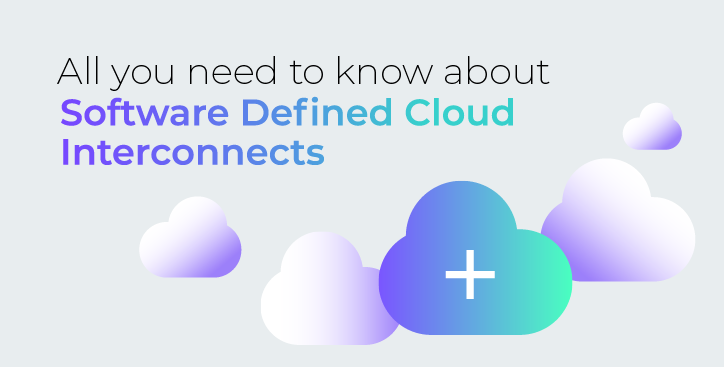All you need to know about Software Defined Cloud Interconnects
By Alex Hawkes|15 May, 2023

Software Defined Cloud Interconnects (SDCIs) offer several advantages over other private cloud connectivity options, and are becoming a key part of enterprise cloud connectivity as businesses consume more business-critical cloud applications.
As enterprises add more public cloud providers and regions, the network becomes more complicated, requiring more accessible private cloud connectivity options.
Industry analyst Gartner recently coined the term Software Defined Cloud Interconnects (SDCIs), encompassing automated private cloud connectivity and Network-as-a-Service (NaaS) solutions like Console Connect, which offer different features and benefits to cloud ports and cloud hubs.
What are Software Defined Cloud Interconnects (SDCIs)?
SDCIs provide private network connectivity between enterprises and public cloud service providers (CSPs) such as AWS, Azure, and Google Cloud. They serve as aggregators and intermediaries to quickly provision logical connectivity to cloud service providers and typically offer a management dashboard that provides billing, monitoring, security, and administration from a single interface.
Especially useful for enterprises using both hybrid and multi-cloud architectures, SDCIs pre-provision physical connectivity via hubs to public cloud service providers, internet service providers (ISPs), network service providers (NSPs), and on-premise infrastructure assets.
They differ from cloud ports, which offer connectivity by and restricted to a specific cloud provider, such as AWS Direct Connect, and Azure ExpressRoute, and from cloud hubs such as Equinix and CoreSite, that provide physical locations offering basic connectivity to multiple cloud providers.
The key difference is that SDCIs enable flexible connectivity to multiple cloud providers in multiple locations and complement this with end-to-end management, API programmability and performance assurance.
Key drivers for Software Defined Cloud Interconnects (SDCIs)
While the public internet may be appropriate for some cloud connectivity requirements, as enterprises adopt more mission critical cloud applications the shortcomings of the internet become more evident.
The public internet is a mish-mash of networks from different operators connected together and service is best effort rather than guaranteed, meaning you have no control of latency, jitter, or pathing.
This makes it entirely unsuitable as a way for enterprises to connect both their private data centres and their public cloud assets. It’s also less than ideal for providing access to cloud-based apps and SaaS solutions, especially those that are mission critical.
As more cloud services are adopted by enterprises, the likelihood of needing private WAN connectivity increases, primarily to deliver:
- Enhanced security: Private cloud connectivity provides a dedicated network that can help protect sensitive data and applications.
- Greater control: Enterprises have greater control over their network infrastructure, allowing them to customise and optimise the network for their specific needs, which can improve network performance and reduce latency.
- Improved reliability: A dedicated network with guaranteed bandwidth and uptime provides improved reliability and availability, ensuring that critical applications and services remain responsive during peak usage periods or in the event of a network outage.
Gartner has put private cloud connectivity options into three buckets, each with its own features and functions.
- Cloud Ports: These are native cloud connectivity options which are restricted to a specific cloud provider, such as AWS Direct Connect, Azure ExpressRoute, and Google Cloud Interconnect.
- Cloud Hubs: These are physical locations typically operated by the large data centre providers such as Equinix, Digital Realty, and CoreSite, that offer connectivity to multiple cloud providers such as AWS, Azure, Google Cloud, IBM, Tencent and more.
- Software Defined Cloud Interconnects (SDCIs): Such as Console Connect offer dedicated Layer 2 and Layer 3 connectivity to multiple cloud providers in multiple locations and augment this with additional services for administration and management.
What are the main benefits of Software Defined Cloud Interconnects (SDCIs)?
SDCIs offer several advantages over other private connectivity options, including:
- Greater flexibility: SDCIs provide greater flexibility than cloud ports or hubs, allowing businesses to establish network connections between multiple cloud providers, data centres, and other network locations. This flexibility allows businesses to choose the most efficient and cost-effective routes for their data traffic, optimising their cloud deployments and reducing latency.
- More efficient use of resources: SDCIs provide a more efficient use of network resources than cloud ports or hubs by dynamically allocating bandwidth and adjusting network capacity as needed, with a flexible approach that matches the nature of the cloud. This can result in cost savings and improved network performance.
- Enhanced security: SDCIs can provide enhanced security by using private and dedicated network connections that bypass the public internet, reducing the risk of data breaches and unauthorised access. Additionally, SDCIs can facilitate the use of advanced security measures such as encryption and access controls.
- Improved scalability: SDCIs are highly scalable and elastic, allowing businesses to easily scale their cloud infrastructure as their needs change, without having to make investments in new hardware or network infrastructure - this is all owned and managed by the SDCI provider.
- Simplified network management: SDCIs such as Console Connect can simplify network management by providing a single, centralised interface for managing network connections, as opposed to the multiple interfaces required for cloud ports and hubs. This can reduce operational costs and improve network management efficiency.
Overall, SDCIs offer a more flexible, efficient, and secure approach to private connectivity than other options like cloud ports and hubs, making them an attractive choice for businesses looking to optimise their cloud deployments.


.jpg)





.jpg)
